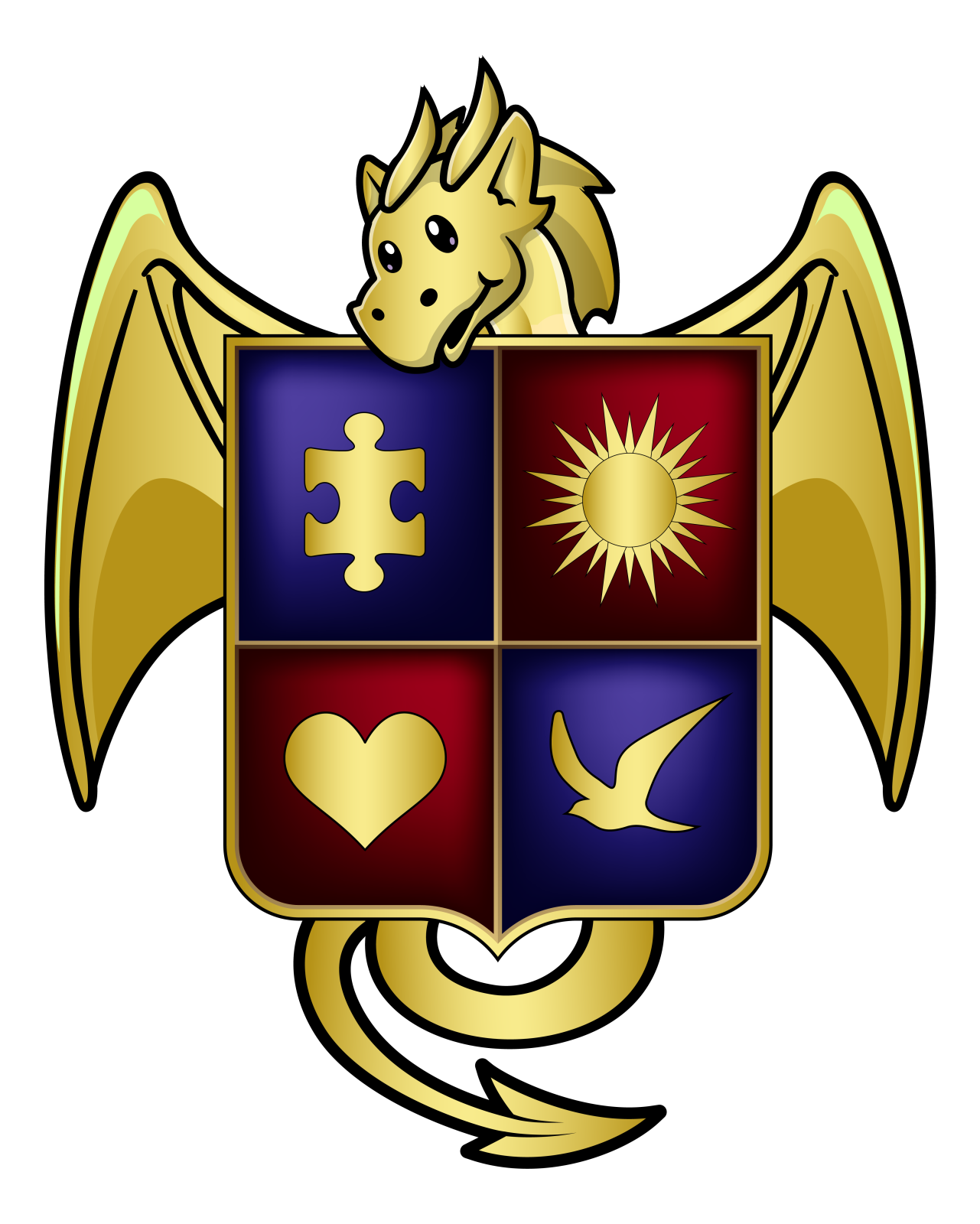STEPS Pathway
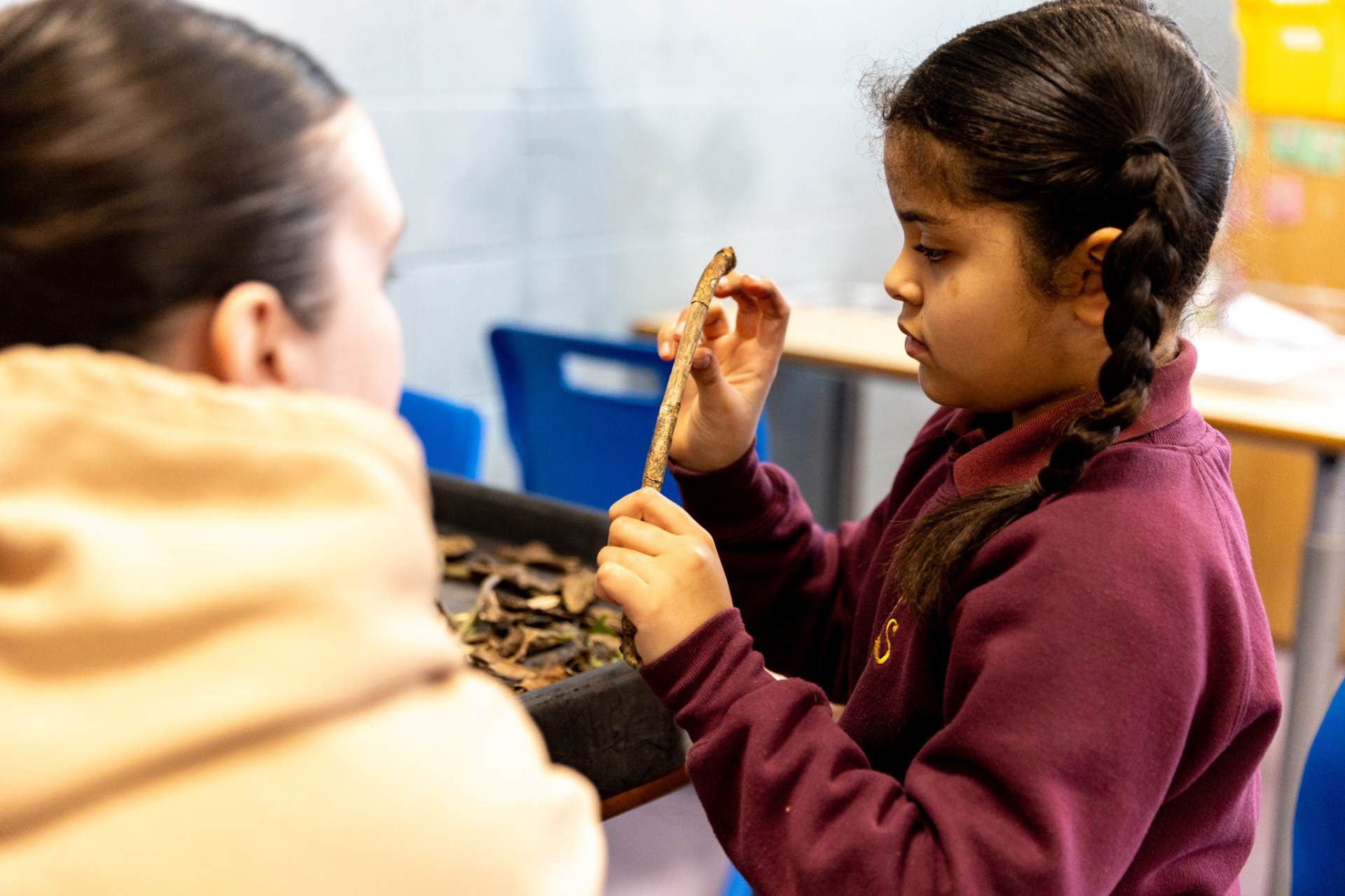
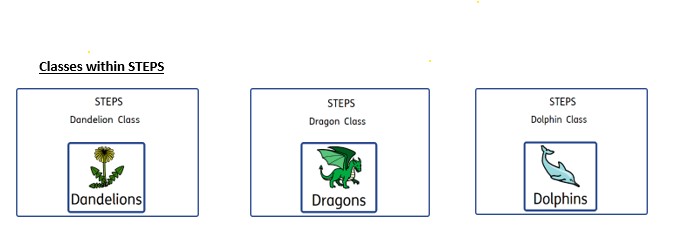
Pathway overview
The STEPS pathway is designed to support learners aged 5-16 with specific needs, helping them to develop essential life skills before transitioning to Safari class in 6th form as the main transition, however students have the opportunity to access inclusion sessions and transition to other pathways within the school, based on their progression. In Safari, students continue to focusing on life skill needed for adulthood. The STEPS pathway emphasizes individual progress in communication, self-regulation, mutual regulation and joint attention, which are prioritizes over academic learning during this stage. This curriculum is designed for students with complex sensory, social and communicative needs, who require an individualised programme. The pathway integrates the SCERTS framework to inform EHCP outcomes, ensuring development in social communication (SC), emotional regulation (ER) and transactional supports (TS). Afternoon lessons align with the Autism education trust (AET) progression frameworks, fostering independence and community engagement. Core academic skills in Math’s and English are tailored using Earwig framework and the Read write inc/fresh start reading programme.
Classes are kept small to ensure tailored support.
Dandelions: Six students
Dandelions serves as the foundation, focusing on students who are social or entering language partners. These students primarily engage in play-based learning, where the emphasis is on fostering communication and engagement with adults and peers. The goal is to help students build the foundational skills they need to interact and connect with others.
From Dandelions, students transition to one of two classes, Dragons or Dolphins, depending on their progression.
Dolphins: Ten students
Dolphins caters to language and conversational partners who are ready to access more structured academic learning. While academic progress becomes a focus, students SEMH and communication needs remain central. Dolphins class also support students in preparing for transitions into other pathways, such as sensory or thematic pathways, as well as the opportunity to access inclusion sessions. Students from Dolphin may transitions to Adventure and Odyssey class when in 6th form.
Dragons: Six students
Dragons is tailored to language and conversational partners who have more complex behavioural/sensory and SEMH needs. The students receive intensive, individualised support, with input from additional professionals such as sensory occupational therapists and educational psychologists. The class structure is designed to address and manage complex sensory, communication and behavior needs through repetition and structured learning opportunities throughout the day. Students in Dragons may move on to Safari class for 6th form, where the focus is on life skills for adulthood or transition to placements better suited to their needs, such as residential, day care settings.
Across all three classes, there is significant input from Speech and language therapy and the behavioural team, alongside class teams. This multidisciplinary approach ensures that student’s timetables and support strategies are tailored to their individual needs, informed by SCERTS assessments and observational monitoring. This cycle allows each student to receive the targeted support they need to achieve their full potential and prepare them for future transitions.
Students are ready to join the STEPS pathway when their primary learning shifts towards improving communication, regulating their emotions and developing joint attention skills. For secondary students, preparation to adult life within the pathway focuses on enabling them to engage with the community, manage their self-regulation to effectively communicate their wants and needs and generalize essential life skills for real-world community settings.
Learners are considered ready to transition to a different pathway when academic learning becomes the primary focus, and students can independently use communication and regulation strategies to support their engagement with learning.
Classes have a high ratio of staffing to support the individualised learning style of the students
|
DANDELIONS |
DRAGONS |
DOLPHINS |
|
Class lead: Kevin Rundell
Class team:
Charlie Julie Sarah
HLTA: Abbie Cruttenden |
Class lead: Sellina Davis/Ben Randall Class team:
Lee Charlotte Leonie Jev Molly
HLTA: Abbie Cruttenden |
Class Lead: Petra Smithers
Class team:
Tish Megan Lisa Netsai
HLTA: Abbie Cruttenden |
Pathway structure
The intent of the STEPS pathway is to provide a highly individualized and structured leaning environment that supports the development of essential communication, self-regulation and life skills. It is designed to meet the needs of leaners with a range of complex needs, enabling them toengage meaningfully with adults, peers and the world around them. The curriculum places a strong emphasis on fostering independence, communication and engagement through carefully planned activities, repetition and personalized support.
Intent of the Pathway
The intent is to support students in progressions from social partners to conversational partners, enabling them to:
- Transition and access community residential, day care placement or personal assistant (PA) support successfully.
- Develop practical communication and self-regulation skills essential for adulthood.
- Build foundational literacy and numeracy skills that support independence.
- Manage complex behaviours with strategies tailored to individual students needs as well as promote independence and awareness in managing their own needs.
Key component and strategies of implementation
1. Communication and engagement
- Communication aids are tailored to each learner and informed by speech and language therapists. Communication aids are consistently used throughout the day. These may include personal communication aids, individualised timetables, visual lists, social stories and specific task boards for AET PM lessons.
- Activities such as bucket time and intensive interaction are incorporated to promote language development, engagement and meaningful connections with adults and peers.
- Repetition is a fundamental aspect of the curriculum, ensuring students can solidify their understanding of key skills and apply them in real-life situation such as community outings, inclusion sessions and role play activities.
2. Life skills and independence
- AET lessons are used to develop independent life skills and understanding of the world. These sessions are designed to encourage interaction and engagement whilst focusing on practical skills.
- Repetition is a critical component of the curriculum, ensuring students solidify their understanding of key skills and can generalise them in various contexts.
- Planned play based learning through SCERTS are implemented with a focus on social communication, joint attention and self-regulation.
3. Individualised learning environments
Each classes learning environment is carefully structured to meet the sensory and learning needs of each student. Students in Dragons and Dolphins class may use TEACCH desks to promote structured learning. These desks provide a clear, and predictable layouts, helping students understand what is expected of them and develop autonomy within their learning. Dandelions offers a less formal learning approach with carousel activities and flexible teaching areas to cater to learners who thrive in a more exploratory setting.
- The TEACCH approach to learning emphasizes structured teaching with clear physical organization, visual schedules and work systems to help learners understand expectations of learning, routines and transitions.
- The structure provided by TEACCH reduces anxiety and promotes self-regulation, directly supporting the emotional regulation goals of SCERTS.
4. Targeted activities and lessons
- Lessons are tailored to support communication, self-regulation and engagement while addressing indivdualised targets.
- Every student within the STEPS pathway have individualised learning plans which are monitored through regular assessments and monitoring from the class team.
Morning session: Focus on SCERTS and academic learning (Maths and English), supported via visual schedules, structured sensory circuits or communication activities to support emotional understanding and regulation.
Afternoon session: Life skills, communication, regulation and independence building activities informed by AET for Dolphin and Dragons and SCERTS in Dandelions. Lessons on understanding emotions, building relationships and developing independence. Life skills and community access support for students from Dolphins and Dragons support students to practice routines such as dressing, meal preparation or visits to the community and reinforce the practical application of SEMH needs.
Language and interaction: Intensive interaction sessions, turn taking games or group play to promote social skills and are embedded throughout the day during schedules time such as playtime, relaxation and choice time. SCERTS informed learning within Dandelions involve lessons on understanding emotions, building relationships and developing independence. In addition, engagement and play-based learning such as bucket time activities, messy play or sensory exploration to encourage curiosity and build focus and expressive language.
By combining individualized support, structured routines and opportunities for engagement, the STEPS curriculum ensures students develop the skills and confidence needed to succeed in their personal lives and social interactions. Every element of the day is planned to enable students to reach their full potential in a way that is meaningful and accessible to them.
Individualised timetable examples
An example of a more detailed individual timetable, this has been created for a student with complex sensory/behaviouiral needs. This plan has been created with input from parents, SALT, sensory OT and behavioural leads and are detailed as a ‘moving curriculum’ students who access these individualised plans may struggle to remain in the main classroom and need to have a focus on their regulation and sensory needs.
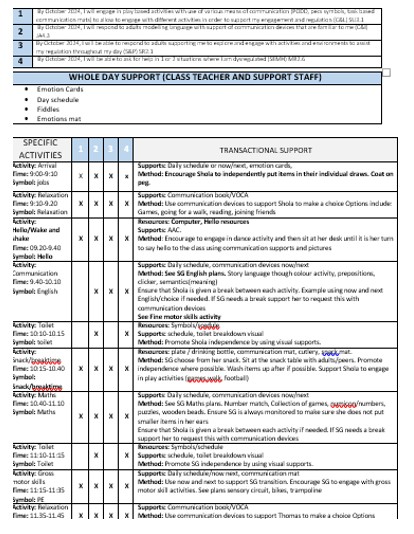
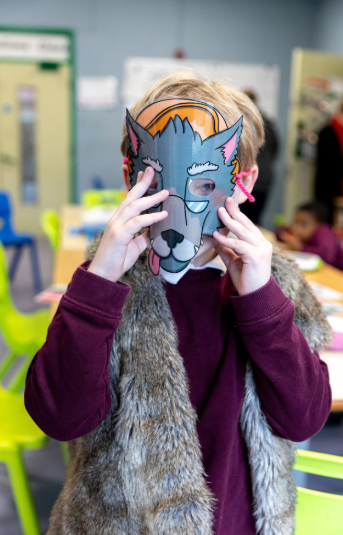
An example of a student who is accessing the main lessons within the class. Students who have these individualised timetable are able to access group learning in the afternoon, however the approach relating resources, timings and language used are amended to meet their individual SCERTS outcomes and communicational needs.
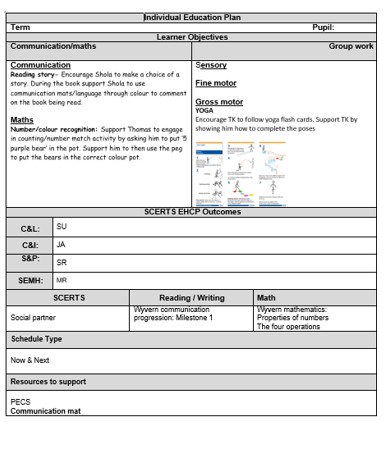
Impact
The curriculum and assessment process within STEPS is designed to have a significant impact on students learning and development, ensuring every student receives personalized support. By utilizing a combination of tailored assessment tools and framework, the curriculum fosters growth in communication, social interaction and life skills, preparing students for adulthood and promoting independence and engagement. Assessments in the STEPS pathway are carefully planned to monitor student progress, inform teaching strategies and adapt learning materials to meet individual needs.
Summative assessments are completed termly to track the overall progress in core areas such as math’s and English. The assessments are informed by EARWIG communication and Math’s milestones, providing structured frameworks to evaluate student’s achievement.
Formative assessments are ongoing, taking places daily during Maths, English and communication lessons. They are tracked through individualized plans which are regularly reviewed and adapted based on student’s progressions and engagement. Teachers use these plans to inform weekly adjustments to lessons materials and teaching strategies, ensuring that each student’s needs and areas of development are addressed.
Functional English
Functional English play a vital role in preparing students to apply essential skills in real-world situations. Through social stories, role play activities, comic book strips, students are able to understand, interpret and manage their emotions and understanding of real life situation which is crucial for their independence and ability to access the world. Functional English is embedded as part of English lessons and have a focus on real-life situation such as going shopping and visiting medical settings.
Phonics
Students who progress beyond the communication framework transition using Read Write Inc. and Fresh start, which focuses on structured phonics and reading strategies to further enhance students literacy development. These approaches ensure that students can build confidence and fluency in Literacy. Baseline phonic assessments are completed by all classes where appropriate for the learners. Assessments provide a clear understanding for each students starting point within the fresh start and RWI reading programme, assessments are then personalised taking into consideration their individual learning needs.
Communication
For students working a pre-entry levels, objectives from the Wyvern communication frameworks are used to guide student’s progression. The frameworks provide a foundation for developing early literacy skills in a way that aligns with their communication needs. Resources are made taking into consideration each learner’s interests, engagement is built upon these interests to further develop their communication needs and engagement of adult led task.
An example of individual assessments
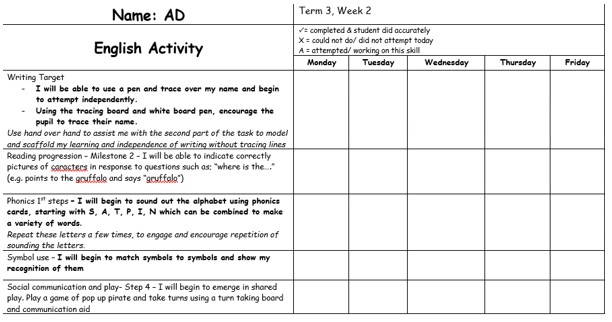
Example of assessments for communication framework
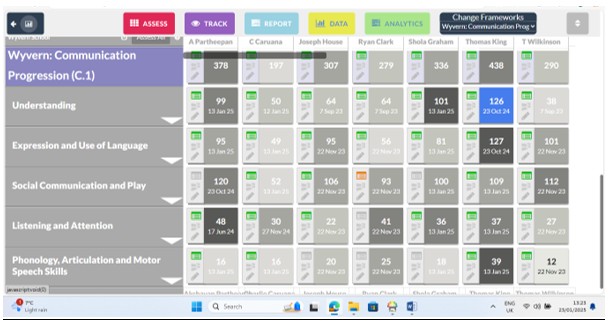
Maths
Maths assessments are completed using EARWIG and ensure that students foundational knowledge, develop key mathematical skills and apply what they know in meaningful context.
- Pre-entry level students follow the Wyvern Maths framework, which emphasizes core concepts such as number recognition, counting and understanding quantities.
- Lessons are designed to be engaging practical, incorporating skills like handling money, telling time as social interaction turn taking games. Which are critical for real-world application.
Functional Maths
The intent of functional Maths is to develop practical and meaningful math’s skills that students can apply in their daily lives. Lessons are structured around snack ensuring learning is relevant and directly applicable. Repetition of visual supports and structure of the activity ensures consistency. By focusing on real –world contexts and individualised learning, students gain the tools to enhance their independence, engagement and confidence navigating everyday tasks
Approaches to learning
|
DANDELIONS |
DRAGONS |
DOLPHINS |
|
Dandelions learn by carousel style of learning. Dandelions students have short bursts of targeted learning. Dandelions learn through play based activities offering constant opportunities to learn skills related to communication, regulation and engagement. Communication and Maths activities are informed via the Wyvern EARWIG assessments
Learning time Maths:3.5 hrs Communication/Phonics:2.5hrs
Students where able access RWI |
Dragons follow the TEACCH programme to deliver learning. Dragons engage in learning in short bursts at a time, following a clearly defined structured to support learning Dragons follow the Wyvern Maths/communication framework, and work on their individual next steps, with the RWI phonics programme being implemented when learners are ready.
Learning time Phonics:3.5hrs Maths:3.5hrs Communication:3.5hrs Students where able access RWI |
Students in Dolphins class follow a more whole class teaching approach based on students ability to regulate their behaviours and communicate their needs. Dolphins engage with maths, phonics and communication either at a 1:1 level or small groups. Dolphins follow the Wyvern Maths/communication framework, and work on their individual next steps, with the RWI phonics programme being implemented when learners are ready.
Learning time Phonics:3.5hrs Maths:3.5hrs Communication: 3.5hrs Students where able access RWI |
Feedback
Where students can communicate their feedback, they ae encouraged to reflect informally on positive aspects of their learning and areas for improvement. For students who are unable to verbally articulate feedback, staff use behavior monitoring such as SLUETH, ABC tally charts and general observations of behaviour throughout the school day to assess engagement and identify areas of success or challenges.
SCERTS assessments
The SCERTS framework is a cornerstone of the STEPS pathway, supporting the development of communication, emotional regulation and social skills. These assessments ae conducted as part of the annual review process, incorporating feedback from parents, carers and teachers observational monitoring. The outcomes are guided by the SCERTS dictionary which breaks down skills into manageable targets to inform termly targets. The framework also identifies specific interpersonal and learning supports to help students to achieve these goals. Additionally AET frameworks are aligned with SCERTS assessments to ensure that the life skills development is personalized and practical, preparing students to access the community and daily routines effectively.
Preparation for adulthood
In STEPS, preparation for adult life involves developing skills necessary for independence and community engagement. As described previously:
- Students are supported in self- regulation, communication, personal care and engagement enabling them to participate in daily life
- Students in Year 11 within STEPS also engage with life skills challenges to ease their transition into Safari (6th form)
More about 6th form SAFARI class – Sensory/STEPS
The students in Safari class transition to 6th Form from the STEPS and the sensory pathways. As such, these young people benefit from a high level of 1-1 support the majority of the time.
Learning style – Safari class use a TEACCH approach, informed by SCERTS, to support their learning; they learn best by completing short bursts of meaningful activities, with time to regulate between each activity. Safari students tend to have complex sensory, social and communicative needs, and require an individualised programme, planned to address this.
Post-19, the majority of Safari student’s access supported living facilities, day provision and support to access the community.
STEPS Pathway

